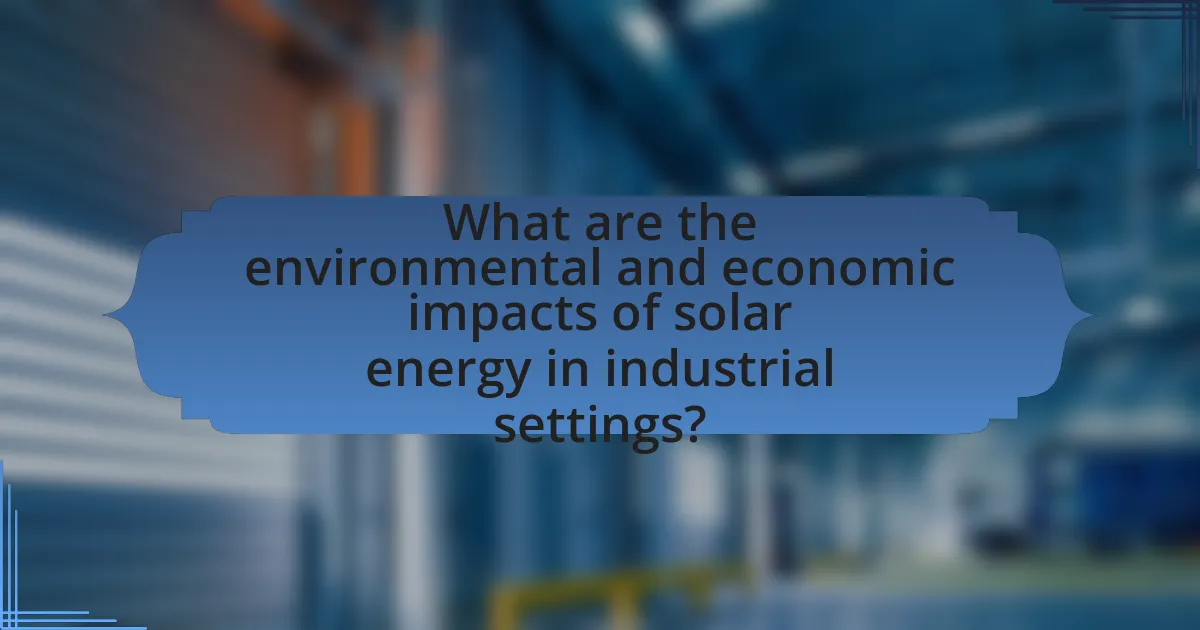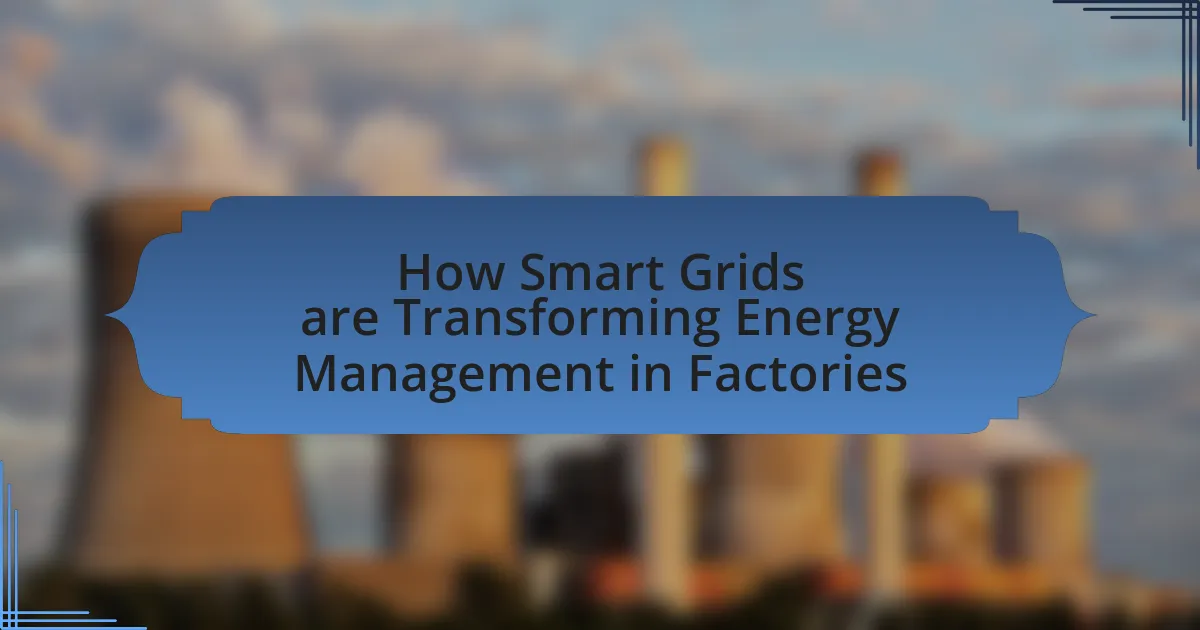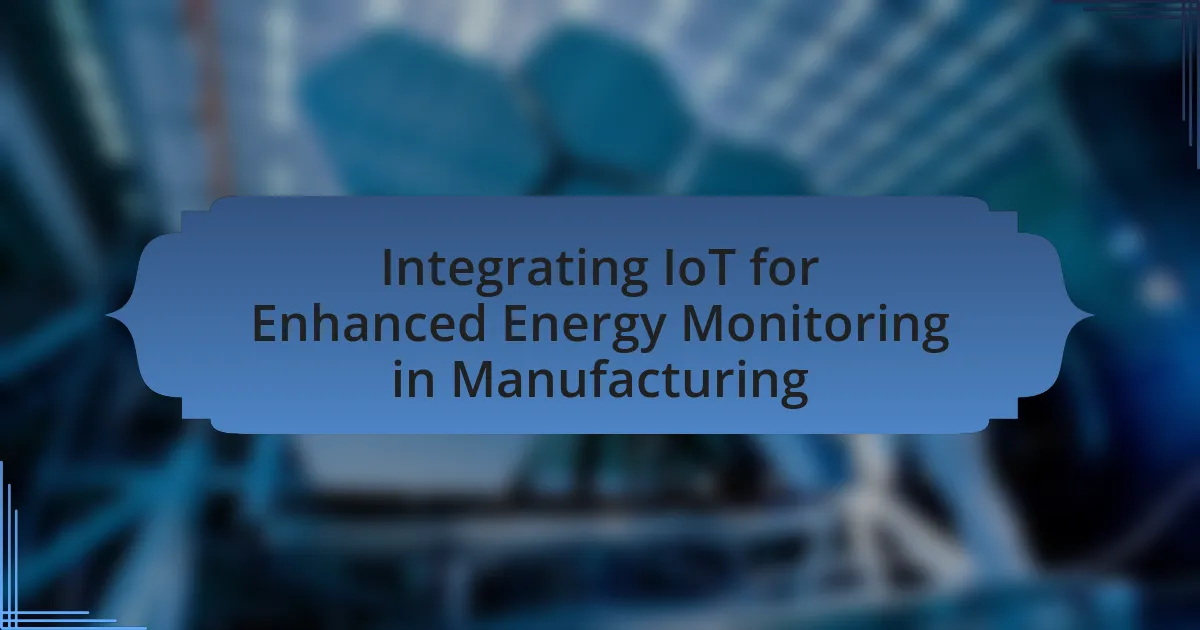The article focuses on best practices for implementing solar energy in industrial facilities, emphasizing the importance of conducting comprehensive energy audits, selecting appropriate solar technologies, and optimizing system design. Key considerations include regulatory compliance, ongoing maintenance, and assessing energy consumption patterns to determine solar energy needs. The article outlines essential steps in planning solar projects, financing options, and technical considerations, while also addressing the environmental and economic impacts of solar energy adoption. Additionally, it highlights the challenges faced during implementation and offers practical tips for successful integration of solar energy systems.
What are the Best Practices for Implementing Solar Energy in Industrial Facilities?

The best practices for implementing solar energy in industrial facilities include conducting a comprehensive energy audit, selecting the appropriate solar technology, optimizing system design, ensuring regulatory compliance, and engaging in ongoing maintenance. Conducting an energy audit helps identify energy consumption patterns and potential savings, which informs the size and type of solar system needed. Choosing the right technology, such as photovoltaic panels or solar thermal systems, is crucial for maximizing efficiency and return on investment. Optimizing system design involves considering factors like roof orientation, shading, and local climate conditions to enhance energy production. Compliance with local regulations and obtaining necessary permits ensures that the installation meets safety and legal standards. Finally, regular maintenance is essential to sustain system performance and longevity, with studies indicating that well-maintained solar systems can operate at 90% efficiency or higher over their lifespan.
How can industrial facilities assess their solar energy needs?
Industrial facilities can assess their solar energy needs by conducting an energy audit to determine current energy consumption patterns and future energy requirements. This audit involves analyzing historical energy usage data, identifying peak demand periods, and evaluating the facility’s operational hours. Additionally, facilities should consider their available roof space or land for solar panel installation, as well as local solar irradiance levels, which can be obtained from solar resource maps or databases. By combining this data, facilities can estimate the size of the solar energy system required to meet their energy needs effectively.
What factors should be considered in a solar energy needs assessment?
A solar energy needs assessment should consider factors such as energy consumption patterns, available solar resources, system size requirements, financial incentives, and regulatory constraints. Energy consumption patterns help determine the amount of solar energy needed to offset usage, while available solar resources, including sunlight hours and intensity, influence system efficiency. System size requirements are based on the facility’s energy needs and roof or land space for installation. Financial incentives, such as tax credits and rebates, can significantly impact the overall cost and feasibility of solar projects. Lastly, regulatory constraints, including local zoning laws and interconnection standards, must be evaluated to ensure compliance and successful implementation.
How do energy consumption patterns influence solar energy implementation?
Energy consumption patterns significantly influence solar energy implementation by determining the optimal size and type of solar systems needed for effective energy offset. Facilities with high and consistent energy usage can benefit from larger solar installations, maximizing return on investment and reducing reliance on grid power. For instance, industries that operate during peak sunlight hours can align their energy consumption with solar generation, enhancing efficiency. According to the U.S. Department of Energy, businesses that analyze their energy consumption patterns can achieve up to 30% savings on energy costs by integrating solar solutions tailored to their specific usage profiles.
What are the key steps in planning a solar energy project?
The key steps in planning a solar energy project include conducting a feasibility study, securing financing, selecting the appropriate technology, obtaining necessary permits, designing the system, and implementing the installation. A feasibility study assesses site conditions, energy needs, and potential savings, which is crucial for informed decision-making. Securing financing involves exploring options such as loans, grants, or partnerships to fund the project. Selecting the appropriate technology ensures that the chosen solar panels and inverters meet the specific energy requirements and budget constraints. Obtaining necessary permits is essential to comply with local regulations and zoning laws. Designing the system involves creating detailed plans that optimize energy production and efficiency. Finally, implementing the installation requires coordinating with contractors and ensuring quality control throughout the process. Each of these steps is critical to the successful execution of a solar energy project, as they collectively ensure that the project is viable, compliant, and effective in meeting energy goals.
How do you conduct a feasibility study for solar energy in industrial settings?
To conduct a feasibility study for solar energy in industrial settings, first assess the site’s solar potential by analyzing geographic location, solar irradiance data, and roof or land space availability. This assessment is crucial as it determines the amount of solar energy that can be harnessed. Next, evaluate the energy consumption patterns of the facility to understand how much energy can be offset by solar power, which can be done by reviewing utility bills and operational schedules.
Following this, conduct a financial analysis that includes initial investment costs, potential savings on energy bills, available incentives, and return on investment (ROI) calculations. For instance, the Solar Energy Industries Association reports that commercial solar installations can yield an ROI of 20% or more, depending on local incentives and energy prices.
Additionally, consider regulatory requirements and permitting processes, as these can impact project timelines and costs. Engaging with local authorities early in the process can streamline this aspect. Finally, perform a risk assessment to identify potential challenges, such as technological changes or market fluctuations, which can affect the project’s viability. This comprehensive approach ensures that all critical factors are evaluated, leading to an informed decision on the feasibility of solar energy implementation in industrial settings.
What role does site selection play in solar energy implementation?
Site selection is crucial in solar energy implementation as it directly influences the efficiency and effectiveness of solar systems. The chosen site must have optimal sunlight exposure, minimal shading, and suitable land characteristics to maximize energy production. For instance, locations with high solar irradiance can increase energy output by up to 20% compared to less favorable sites. Additionally, proximity to existing infrastructure, such as power lines and roads, can reduce installation costs and enhance grid connectivity. Therefore, careful site selection ensures that solar energy systems operate at their highest potential, contributing to overall project success.
What financing options are available for solar energy projects?
Financing options available for solar energy projects include direct purchase, solar loans, power purchase agreements (PPAs), and leasing. Direct purchase allows organizations to buy solar systems outright, providing long-term savings and tax benefits. Solar loans enable financing through banks or credit unions, allowing for ownership while spreading costs over time. Power purchase agreements involve a third party installing the solar system and selling the generated power back to the facility at a predetermined rate, often lower than utility rates. Leasing allows organizations to use solar systems without upfront costs, paying a monthly fee instead. These options cater to various financial situations and project scales, making solar energy accessible to a wider range of industrial facilities.
How can industrial facilities leverage government incentives for solar energy?
Industrial facilities can leverage government incentives for solar energy by applying for tax credits, grants, and rebates specifically designed to promote renewable energy adoption. These incentives, such as the Federal Investment Tax Credit (ITC), which allows businesses to deduct a significant percentage of solar installation costs from their federal taxes, can substantially reduce the upfront financial burden of solar projects. Additionally, many states offer their own incentives, including performance-based incentives that reward energy production, further enhancing the financial viability of solar investments. By strategically utilizing these government programs, industrial facilities can lower their capital expenditures, improve return on investment, and contribute to sustainability goals.
What are the pros and cons of different financing models for solar energy?
Different financing models for solar energy, such as outright purchase, power purchase agreements (PPAs), and leasing, each have distinct pros and cons. Outright purchase allows for full ownership and potential tax benefits, but requires significant upfront capital. PPAs provide a low or no upfront cost and predictable energy pricing, yet they may limit ownership benefits and have long-term commitments. Leasing offers flexibility and lower initial costs, but can result in higher overall expenses and lack of ownership incentives. Each model’s effectiveness varies based on financial capacity, energy needs, and long-term goals, making careful consideration essential for industrial facilities.
What technical considerations are important for solar energy systems?

Technical considerations important for solar energy systems include system design, efficiency, and integration with existing infrastructure. System design involves selecting appropriate solar panels, inverters, and mounting systems to optimize energy capture based on location and environmental conditions. Efficiency is critical, as higher efficiency panels convert more sunlight into electricity, directly impacting energy output and return on investment. Integration with existing infrastructure ensures compatibility with electrical systems and maximizes energy use, which is essential for industrial facilities aiming to reduce operational costs and carbon footprint.
How do you choose the right solar technology for industrial applications?
To choose the right solar technology for industrial applications, assess the specific energy needs, available space, and budget constraints of the facility. Evaluating energy consumption patterns helps determine the required capacity, while analyzing roof or land space informs the type of solar system, such as rooftop or ground-mounted installations. Additionally, budget considerations will influence the choice between technologies like photovoltaic (PV) panels or concentrated solar power (CSP). According to the U.S. Department of Energy, PV systems are generally more cost-effective for most industrial applications, with prices dropping by over 70% since 2010, making them a viable option for many facilities.
What are the differences between photovoltaic and solar thermal systems?
Photovoltaic systems convert sunlight directly into electricity using solar cells, while solar thermal systems capture sunlight to produce heat for various applications. Photovoltaic systems utilize semiconductor materials to generate electrical energy, which can be used immediately or stored in batteries. In contrast, solar thermal systems typically use collectors to absorb solar energy, which is then transferred to a fluid that heats water or air for heating purposes. The efficiency of photovoltaic systems is generally measured in terms of electrical output, while solar thermal systems are evaluated based on their ability to generate heat.
How does system size impact performance and cost?
System size significantly impacts both performance and cost in solar energy implementations for industrial facilities. Larger systems typically yield higher energy output due to increased solar panel capacity, which enhances overall efficiency and reduces the cost per watt of electricity generated. For instance, a study by the National Renewable Energy Laboratory found that economies of scale in larger solar installations can lead to a reduction in installation costs by up to 20% compared to smaller systems. Additionally, larger systems can benefit from better financing options and incentives, further lowering the overall cost. Conversely, smaller systems may incur higher costs per unit of energy produced, resulting in less favorable return on investment.
What are the best practices for installation and maintenance of solar systems?
The best practices for installation and maintenance of solar systems include proper site assessment, professional installation, regular inspections, and timely repairs. Conducting a thorough site assessment ensures optimal placement and orientation of solar panels to maximize sunlight exposure, which is crucial for efficiency. Engaging certified professionals for installation guarantees adherence to safety standards and local regulations, reducing the risk of future issues. Regular inspections, ideally twice a year, help identify potential problems such as dirt accumulation or shading from nearby structures, which can hinder performance. Timely repairs and maintenance, including cleaning panels and checking electrical connections, are essential to maintain system efficiency and longevity. Following these practices can lead to improved energy output and a longer lifespan for solar systems.
How can industrial facilities ensure proper installation of solar panels?
Industrial facilities can ensure proper installation of solar panels by engaging qualified professionals for the design and installation process. Utilizing certified solar installers who adhere to industry standards and local regulations minimizes risks associated with improper installation. Furthermore, conducting a thorough site assessment to evaluate structural integrity, shading, and orientation is essential for optimal panel placement. According to the National Renewable Energy Laboratory, proper installation can enhance system performance by up to 30%. Regular inspections and maintenance post-installation also contribute to long-term efficiency and reliability of the solar energy system.
What maintenance practices are essential for maximizing solar energy efficiency?
Regular cleaning of solar panels is essential for maximizing solar energy efficiency, as dirt, dust, and debris can significantly reduce energy output. Studies indicate that unclean panels can lose up to 25% of their efficiency. Additionally, routine inspections for damage, such as cracks or loose connections, help ensure optimal performance. Monitoring system performance through data analytics allows for early detection of issues, enabling timely repairs. Furthermore, ensuring that the inverter and other electrical components are functioning correctly is crucial, as these elements convert solar energy into usable electricity. Regular maintenance, including checking for shading from nearby trees or structures, also plays a vital role in maintaining efficiency.
How can industrial facilities integrate solar energy with existing systems?
Industrial facilities can integrate solar energy with existing systems by installing photovoltaic (PV) panels on rooftops or unused land, which allows them to generate electricity on-site. This integration can be achieved through grid-tied systems that connect the solar output to the facility’s electrical infrastructure, enabling the use of solar energy for operational needs while reducing reliance on conventional energy sources. According to the U.S. Department of Energy, facilities that adopt solar energy can reduce energy costs by 20-50%, demonstrating the financial benefits of this integration. Additionally, implementing energy management systems can optimize the use of solar energy alongside existing power sources, ensuring efficient energy consumption and enhancing sustainability efforts.
What are the challenges of integrating solar energy into traditional energy systems?
Integrating solar energy into traditional energy systems presents several challenges, including intermittency, grid compatibility, and infrastructure costs. Intermittency refers to the variable nature of solar energy production, which can lead to supply fluctuations that traditional energy systems may struggle to accommodate. Grid compatibility issues arise when existing infrastructure is not equipped to handle the decentralized nature of solar energy generation, requiring upgrades or modifications. Additionally, the initial infrastructure costs for solar installations can be significant, posing financial barriers for industries looking to transition to renewable energy sources. These challenges necessitate careful planning and investment to ensure a successful integration of solar energy into existing energy frameworks.
How can energy storage solutions enhance solar energy utilization?
Energy storage solutions enhance solar energy utilization by allowing for the capture and storage of excess solar energy generated during peak sunlight hours for use during periods of low sunlight or high demand. This capability increases the overall efficiency and reliability of solar energy systems, enabling facilities to reduce reliance on grid power and lower energy costs. For instance, according to the U.S. Department of Energy, integrating energy storage with solar can increase self-consumption rates by up to 80%, significantly improving the economic viability of solar installations in industrial settings.
What are the environmental and economic impacts of solar energy in industrial settings?

The environmental impacts of solar energy in industrial settings include reduced greenhouse gas emissions and lower air pollution levels, while the economic impacts encompass cost savings on energy bills and potential revenue from selling excess energy back to the grid. Specifically, solar energy systems can decrease carbon dioxide emissions by approximately 80% compared to fossil fuels, contributing to climate change mitigation. Economically, industries that adopt solar energy can save an average of 20-30% on energy costs, and in some regions, they can earn additional income through net metering policies, which allow them to sell surplus energy.
How does solar energy contribute to sustainability in industrial operations?
Solar energy significantly contributes to sustainability in industrial operations by reducing greenhouse gas emissions and lowering energy costs. By harnessing solar power, industries can decrease their reliance on fossil fuels, which are major contributors to climate change. For instance, a study by the National Renewable Energy Laboratory found that large-scale solar installations can reduce carbon dioxide emissions by approximately 1,000 tons per megawatt per year. Additionally, solar energy systems can lead to substantial savings on electricity bills, allowing companies to reinvest those funds into sustainable practices and technologies. This dual benefit of environmental impact and economic efficiency underscores the role of solar energy in promoting sustainability within industrial sectors.
What are the long-term environmental benefits of using solar energy?
The long-term environmental benefits of using solar energy include significant reductions in greenhouse gas emissions and decreased reliance on fossil fuels. Solar energy systems produce electricity without emitting carbon dioxide or other harmful pollutants, which contributes to cleaner air and mitigates climate change. According to the U.S. Environmental Protection Agency, transitioning to solar energy can reduce carbon emissions by approximately 80% compared to traditional energy sources over their operational lifetime. Additionally, solar energy helps conserve water, as it requires minimal water for operation compared to fossil fuel extraction and processing, which can consume vast amounts of water. This conservation is crucial in areas facing water scarcity. Overall, the adoption of solar energy leads to a more sustainable and healthier environment for future generations.
How can solar energy reduce carbon footprints in industrial facilities?
Solar energy can significantly reduce carbon footprints in industrial facilities by replacing fossil fuel-based energy sources with clean, renewable energy. By harnessing solar power, industrial facilities can decrease their greenhouse gas emissions, as solar energy systems produce electricity without emitting carbon dioxide during operation. For instance, a study by the National Renewable Energy Laboratory found that large-scale solar installations can reduce carbon emissions by up to 90% compared to traditional energy sources. This transition not only contributes to a lower carbon footprint but also enhances energy independence and sustainability for industrial operations.
What economic advantages does solar energy offer to industrial facilities?
Solar energy provides significant economic advantages to industrial facilities, primarily through reduced energy costs and increased energy independence. By installing solar panels, industrial facilities can generate their own electricity, leading to lower utility bills and protection against fluctuating energy prices. According to the Solar Energy Industries Association, businesses can save up to 75% on energy costs over the lifespan of solar systems. Additionally, solar energy can enhance a facility’s sustainability profile, potentially attracting eco-conscious customers and investors, which can further improve profitability.
How can solar energy lead to cost savings in operational expenses?
Solar energy can lead to cost savings in operational expenses by significantly reducing electricity bills. When industrial facilities install solar panels, they generate their own electricity, which decreases reliance on grid power and lowers monthly energy costs. According to the U.S. Department of Energy, businesses that adopt solar energy can save between 20% to 50% on their energy bills over time. Additionally, solar energy systems often have low maintenance costs, further contributing to overall savings. The combination of reduced energy expenses and minimal upkeep makes solar energy a financially advantageous choice for industrial operations.
What is the return on investment for solar energy projects in industrial settings?
The return on investment (ROI) for solar energy projects in industrial settings typically ranges from 10% to 30% annually. This ROI is influenced by factors such as installation costs, energy savings, and available incentives. For instance, a study by the National Renewable Energy Laboratory found that industrial facilities can achieve payback periods of 5 to 7 years, leading to significant long-term savings on energy costs. Additionally, tax credits and rebates can enhance the financial benefits, making solar energy a viable investment for many industries.
What are the common challenges faced when implementing solar energy?
Common challenges faced when implementing solar energy include high initial costs, regulatory hurdles, and technological limitations. High initial costs can deter investment, as solar panel installation and associated infrastructure require significant capital. Regulatory hurdles often arise from complex permitting processes and varying state policies, which can delay project timelines. Additionally, technological limitations, such as energy storage capacity and efficiency of solar panels, can impact the reliability and effectiveness of solar energy systems. These challenges are supported by data indicating that upfront costs can account for up to 30% of total project expenses, and regulatory delays can extend project timelines by several months to years.
How can industrial facilities overcome regulatory hurdles in solar energy projects?
Industrial facilities can overcome regulatory hurdles in solar energy projects by engaging with local authorities early in the planning process. This proactive approach allows facilities to understand specific regulations, permitting requirements, and potential obstacles unique to their location. For instance, facilities can conduct thorough site assessments to identify zoning restrictions and environmental regulations that may impact project feasibility. Additionally, collaborating with experienced consultants or legal experts can provide insights into navigating complex regulatory frameworks. According to the Solar Energy Industries Association, early engagement with stakeholders can significantly reduce project delays and increase the likelihood of successful permitting.
What are the risks associated with solar energy implementation, and how can they be mitigated?
The risks associated with solar energy implementation include high initial costs, land use conflicts, energy production variability, and potential environmental impacts. High initial costs can be mitigated through financing options such as power purchase agreements and government incentives, which can lower the financial burden on industrial facilities. Land use conflicts can be addressed by conducting thorough site assessments and selecting locations that minimize disruption to existing ecosystems and communities. Energy production variability can be managed by integrating energy storage solutions and utilizing predictive analytics to optimize energy usage. Lastly, potential environmental impacts can be reduced by adhering to environmental regulations and conducting environmental impact assessments prior to installation, ensuring that solar projects are sustainable and responsible.
What practical tips can help ensure successful solar energy implementation?
To ensure successful solar energy implementation, conduct a thorough site assessment to evaluate solar potential and system requirements. This assessment should include analyzing roof orientation, shading, and structural integrity, which are critical for maximizing energy production. Additionally, selecting high-quality solar panels and inverters is essential, as they significantly impact efficiency and longevity. According to the National Renewable Energy Laboratory, using reliable components can enhance system performance and reduce maintenance costs. Furthermore, engaging experienced installers who understand local regulations and incentives can streamline the installation process and ensure compliance with safety standards.
How can facilities create a comprehensive solar energy strategy?
Facilities can create a comprehensive solar energy strategy by conducting a thorough assessment of their energy needs and available solar resources. This involves analyzing current energy consumption patterns, identifying potential solar installation sites, and evaluating local solar incentives and regulations.
For instance, a study by the National Renewable Energy Laboratory indicates that facilities can optimize their solar energy strategy by integrating energy storage solutions, which enhance reliability and efficiency. Additionally, engaging with solar energy consultants can provide tailored insights and facilitate the design of a system that aligns with the facility’s operational goals.
What role does employee training play in the successful adoption of solar energy?
Employee training is crucial for the successful adoption of solar energy as it equips staff with the necessary skills and knowledge to operate and maintain solar systems effectively. Trained employees can optimize energy production, troubleshoot issues, and ensure compliance with safety and regulatory standards. Research indicates that organizations with comprehensive training programs experience a 20% increase in operational efficiency and a 15% reduction in maintenance costs related to solar energy systems. This demonstrates that effective employee training directly contributes to the overall success and sustainability of solar energy initiatives in industrial facilities.




